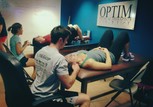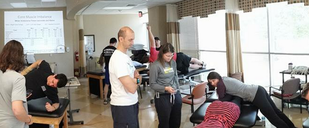- Home
- About Us
- TSPT Academy
- Online Courses
-
Resources
- Newsletter
- Business Minded Sports Physio Podcast
- Day in the Life of a Sports PT
- Residency Corner
-
Special Tests
>
-
Cervical Spine
>
- Alar Ligament Test
- Bakody's Sign
- Cervical Distraction Test
- Cervical Rotation Lateral Flexion Test
- Craniocervical Flexion Test (CCFT)
- Deep Neck Flexor Endurance Test
- Posterior-Anterior Segmental Mobility
- Segmental Mobility
- Sharp-Purser Test
- Spurling's Maneuver
- Transverse Ligament Test
- ULNT - Median
- ULNT - Radial
- ULNT - Ulnar
- Vertebral Artery Test
- Thoracic Spine >
-
Lumbar Spine/Sacroiliac Joint
>
- Active Sit-Up Test
- Alternate Gillet Test
- Crossed Straight Leg Raise Test
- Extensor Endurance Test
- FABER Test
- Fortin's Sign
- Gaenslen Test
- Gillet Test
- Gower's Sign
- Lumbar Quadrant Test
- POSH Test
- Posteroanterior Mobility
- Prone Knee Bend Test
- Prone Instability Test
- Resisted Abduction Test
- Sacral Clearing Test
- Seated Forward Flexion Test
- SIJ Compression/Distraction Test
- Slump Test
- Sphinx Test
- Spine Rotators & Multifidus Test
- Squish Test
- Standing Forward Flexion Test
- Straight Leg Raise Test
- Supine to Long Sit Test
-
Shoulder
>
- Active Compression Test
- Anterior Apprehension
- Biceps Load Test II
- Drop Arm Sign
- External Rotation Lag Sign
- Hawkins-Kennedy Impingement Sign
- Horizontal Adduction Test
- Internal Rotation Lag Sign
- Jobe Test
- Ludington's Test
- Neer Test
- Painful Arc Sign
- Pronated Load Test
- Resisted Supination External Rotation Test
- Speed's Test
- Posterior Apprehension
- Sulcus Sign
- Thoracic Outlet Tests >
- Yergason's Test
- Elbow >
- Wrist/Hand >
- Hip >
- Knee >
- Foot/Ankle >
-
Cervical Spine
>
- I want Financial Freedom
- I want Professional Growth
- I want Clinical Mastery
 I often hear the terminology open-packed and close-packed joint positions used in the clinic. In general, clinicians know to mobilize in the open-packed position and avoid manipulation in a close-packed position, but what else should we know about these terms? Is there any other clinical significance to the open v. close-packed positions? In this post I will review these 2 positions and discuss the clinical relevance of each.
 How Should PT's Interpret Open vs Close-Packed Clinically? As I mentioned above, it is important to start your joint assessment and treatment in the open-packed position. Since the joint has the most available room for movement, mobilizations are best tolerated in this position. For example, the open-packed position of the knee is 25 degrees of flexion. The close-packed position is full extension. At 25 degrees of flexion the knee is loose- one can assess varus and valgus ligament stress testing or check tibial IR/ER mobility in this position. Biomechanically, the knee is 'unlocked.' Following an injury, the body favors this position because there is space for swelling and other fluid to accumulate within the joint. As the patient's ROM improves, pain decreases, and the swelling subsides, the clinician can start to mobilize the joint in other positions of flexion and extension as needed. Additionally, understanding the open and closed packed positions is essential when performing manipulations. We want to manipulate a joint in the open-packed position, but often times we cannot target a specific joint unless we lock out or close-pack the surrounding joints. For example, when performing a prone SIJ distraction manipulation, the hip needs to be placed in extension, abduction, and internal rotation. These three movements are the close-packed position of the hip joint. You must lock out the hip so you do not manipulate it when you are targeting the SIJ. Each joint has a different open and close packed position and being able to quickly recall that position will make you a more efficient clinician. If you do not understand the open and close-packed positions of regional joints, the specificity of your techniques will decrease. Jim
13 Comments
Ahmad
5/8/2016 10:52:30 am
U mentioned that we need to put the hip in abduction to perform sij distraction. So how do you put the hip in abduction?
Reply
Jesse
5/25/2016 01:51:08 pm
Abduct it.
Reply
Howard Chauvin
5/30/2019 12:12:05 pm
hahaaa,,, EXACTLY
K
12/30/2016 03:38:31 pm
If your legs are together, just bring them away from midline (like what you'd do in a jumping jack)
Reply
Howard Chauvin
5/30/2019 12:10:05 pm
Ahmad, if you do not know how to abduct your hip,,,, you definitely should NOT be performing joint distractions
Reply
josh
12/13/2018 12:05:03 pm
Is the full body close-packed position prone, with legs and arms extended/abducted, wrists extended, and ankles dorsiflexed (like a swimmer's position)?
Reply
victoria
9/18/2019 11:37:59 pm
ok so how adduct, in?
Reply
Dan
2/16/2020 02:03:09 am
If you want to adduct right leg, u should first slightly abduct the opposite leg ( left leg ) then you move the right leg toward the other leg to be able to adduct it
Reply
Ahmed
2/23/2020 09:50:32 am
the close packed position is not the position pf congruency
Reply
Jo
5/9/2020 02:47:12 am
Hi Ahmed, I believe you got that from another website, is that correct?
Reply
Ömer Can
5/28/2021 12:46:58 pm
Hi thanks a lot and i'm PT also, so can you give me another specific example like this ::
Reply
Leave a Reply. |
Dr. Brian Schwabe's NEW Book in partner with PaleoHacks!
Learn residency-level content on our
Insider Access pages We value quality PT education & CEU's. Click the MedBridge logo below for TSPT savings!Archives
July 2019
Categories
All
|






 RSS Feed
RSS Feed